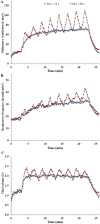Customizing intense interval exercise training prescription using the "frequency, intensity, time, and type of exercise" (FITT) principle
- PMID: 40247924
- PMCID: PMC12003422
- DOI: 10.3389/fphys.2025.1553846
Customizing intense interval exercise training prescription using the "frequency, intensity, time, and type of exercise" (FITT) principle
Abstract
Intense interval exercise training induces various physiological and metabolic adaptations related to performance and health. For designing a program, the F.I.T.T. principle, referring to frequency, intensity, time, and type of exercise, can be used to manipulate the level of physiological stress in the body, leading to various adaptations. Modifying these four parameters results in a wide range of interval protocols that are safe and effective for different populations including athletes and individuals with chronic diseases. In this review, we present how the manipulation of the F.I.T.T. components can alter the acute and chronic cardiorespiratory, metabolic, perceptual, and affective responses and adaptations to intense interval exercise training. From this evidence, it appears that the duration of the exercise bout and recovery interval are critical parameters for the manipulation of almost all acute responses, enabling periodization of intense interval exercise training, and promoting optimal adaptations and exercise adherence. In addition, a considerable level of adaptations may be achieved with training frequencies as low as once or twice per week and with lower than maximal intensities, adding to the feasibility of this exercise mode. Overall, by varying these parameters, the design of an intense interval exercise training program can be tailored according to the needs and abilities of each individual, and an optimized training prescription may be achieved.
Keywords: blood lactate concentration; cardiorespiratory fitness; frequency; heart rate; high intensity interval training; metabolic; perceptual responses; sprint interval training.
Copyright © 2025 Stavrinou, Astorino, Giannaki, Aphamis and Bogdanis.
Conflict of interest statement
The authors declare that the research was conducted in the absence of any commercial or financial relationships that could be construed as a potential conflict of interest. The author(s) declared that they were an editorial board member of Frontiers, at the time of submission. This had no impact on the peer review process and the final decision.
Figures


Similar articles
-
High-intensity interval training, solutions to the programming puzzle. Part II: anaerobic energy, neuromuscular load and practical applications.Sports Med. 2013 Oct;43(10):927-54. doi: 10.1007/s40279-013-0066-5. Sports Med. 2013. PMID: 23832851 Review.
-
High-intensity interval training, solutions to the programming puzzle: Part I: cardiopulmonary emphasis.Sports Med. 2013 May;43(5):313-38. doi: 10.1007/s40279-013-0029-x. Sports Med. 2013. PMID: 23539308 Review.
-
The science of cycling: physiology and training - part 1.Sports Med. 2005;35(4):285-312. doi: 10.2165/00007256-200535040-00002. Sports Med. 2005. PMID: 15831059 Review.
-
Low-frequency severe-intensity interval training improves cardiorespiratory functions.Med Sci Sports Exerc. 2015 Apr;47(4):789-98. doi: 10.1249/MSS.0000000000000477. Med Sci Sports Exerc. 2015. PMID: 25137370 Clinical Trial.
-
Effects of Passive or Active Recovery Regimes Applied During Long-Term Interval Training on Physical Fitness in Healthy Trained and Untrained Individuals: A Systematic Review.Sports Med Open. 2024 Mar 5;10(1):21. doi: 10.1186/s40798-024-00673-0. Sports Med Open. 2024. PMID: 38443585 Free PMC article.
References
Publication types
LinkOut - more resources
Full Text Sources

